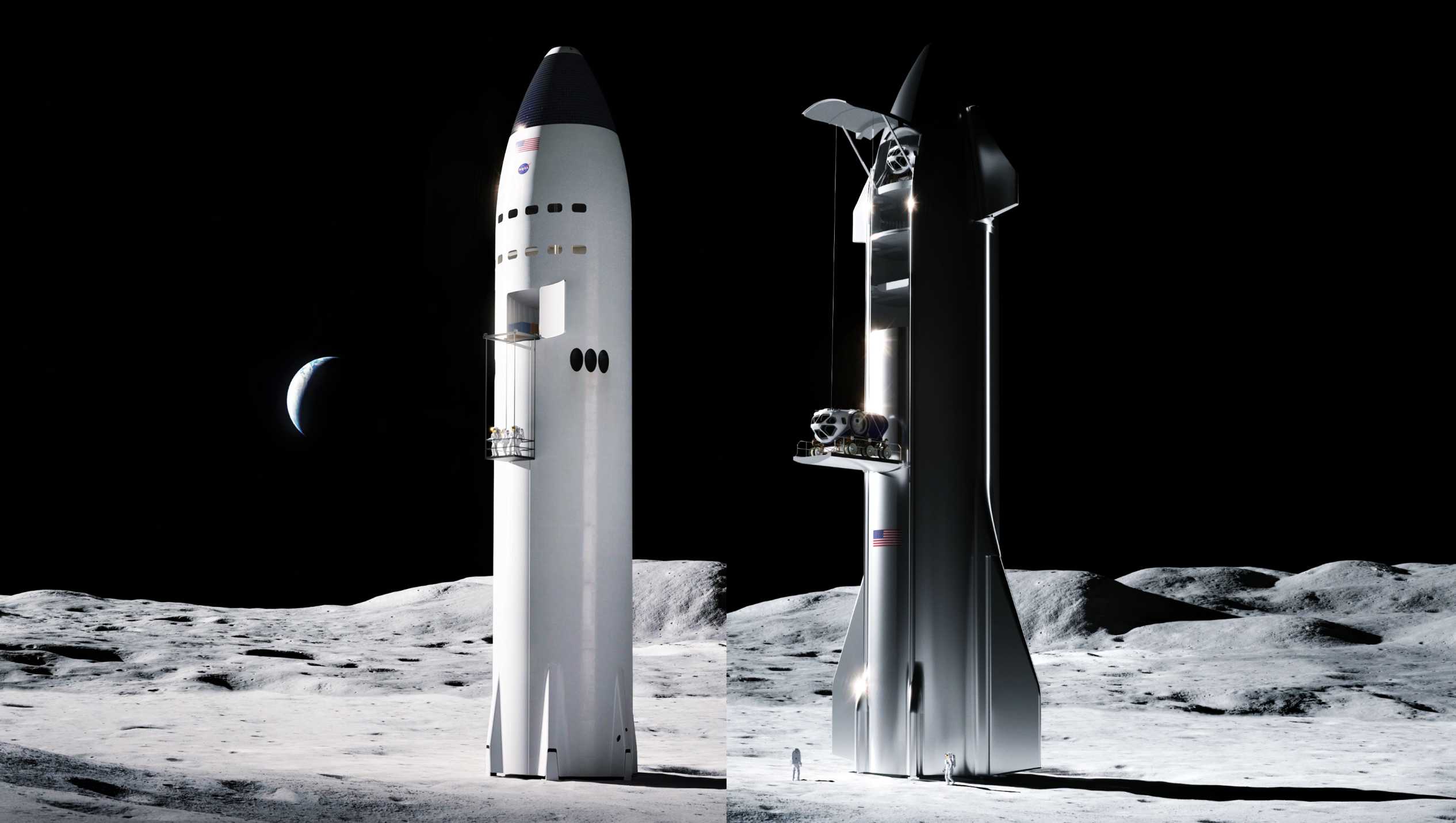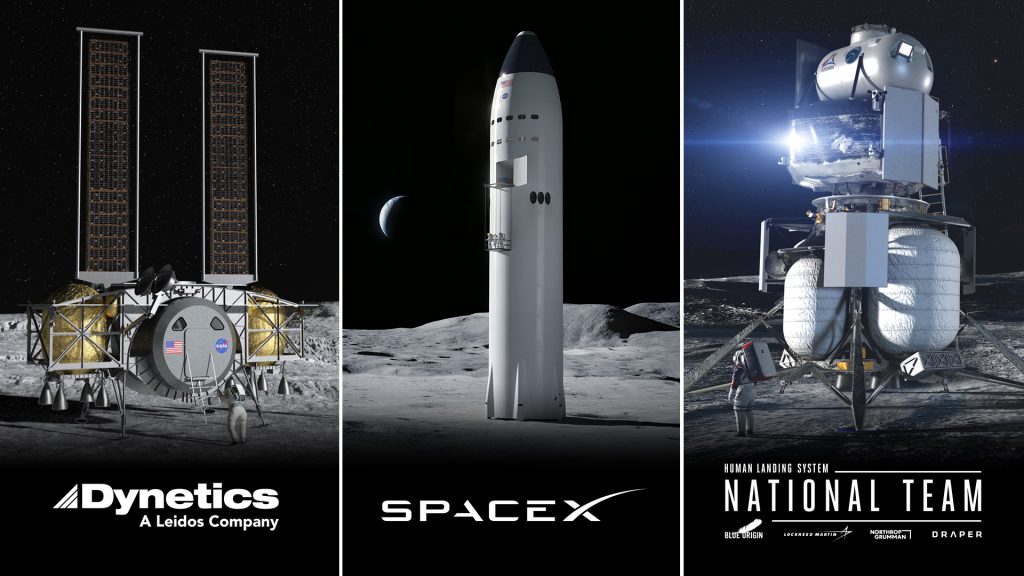

News
SpaceX rapidly builds, tests Starship Moon elevator for NASA
As part of a NASA program that will select one or two commercial crewed Moon landers, SpaceX is busy testing Starship and prototyping hardware and most recently built and demonstrated an elevator “in a very short period of time.”
Known as the Human Landing System (HLS) program, NASA selected three providers – a Blue Origin-led consortium, Dynetics, and SpaceX – to build prototypes and compete for one or two follow-on contracts back in April 2020. SpaceX’s Starship offering was deemed the riskiest solution and the company received a middling $135 million to Dynetics’ ~$250 million and the “National Team’s” ~$570 million.
For their ~$820 million investment, it’s unclear what exactly NASA has gotten from its two best-funded teams aside from paperwork, a few completed design reviews, and two low-fidelity mockups mostly made out of cardboard, foam, and wood. Meanwhile, in the ten months since SpaceX received its $135 million, the company has built no less than eight full-scale Starship prototypes, performed a dozen or more wet dress rehearsals and static fires with said prototypes, and performed two powered hops and two high-altitude test flights. Now, to add to that list of low-cost achievements, SpaceX has also built and tested a functioning prototype of the elevator Starship would use to lift and lower astronauts to and from the lunar surface.
SpaceX’s proposal is certainly a unique one, with Starship being no less than several times taller and heavier than both its prospective competitors. However, Blue Origin’s extraordinarily complex three-stage, four-component lander – requiring a separate transfer stage, descent stage, ascent stage, and crew cabin – makes even Starship seem somewhat reasonable.
Notably, that massive 8-10m (25-32 ft) stack of separate spacecraft – crew cabin at the peak – would force NASA astronauts to transit a several-story ladder to and from the lunar surface. Far taller than the Apollo Program’s lander ladder, which NASA was already somewhat tepid on at the time, navigating a tall ladder in a clumsy, imprecise lunar EVA spacesuit would be extremely challenging and relatively risky. Dynetics is by far the least concerning solution in that regard, requiring what amounts to a footstool relative to SpaceX and Blue Origin.

In the National Team’s defense, SpaceX’s elevator approach is also undeniably risky, and it’s safe to say that demonstrated reliability would be an absolute necessity for NASA to ever accept that solution. Of course, SpaceX could feasibly include a hand-cranked backup system and a ladder on Starship’s exterior in the event of total system failure, but both backups would still pose risks similar to or greater than the National Team’s ladder.
However, the fact that SpaceX has already built and begun testing a Starship Moon elevator prototype makes it hard to believe that the company couldn’t ultimately produce a safe, reliable, redundant elevator between now and the mid to late 2020s.
On a separate note, it’s unclear when or where SpaceX built and tested the first Starship elevator. The photo NASA’s Mark Kirasich provider appears to show an elevator prototype situated inside a steel Starship ring with the sky visible, but nothing like that setup has been spotted at SpaceX’s Boca Chica Starship factory or former Cocoa Beach production facilities. That leaves its Hawthorne, California factory or, perhaps, a mysterious “Roberts Road” facility on Kennedy Space Center (KSC) land. Either way, it certainly appears that SpaceX has yet to show all its cards and is doing everything it can to convince NASA that Starship is worth additional HLS contracts.
NASA is expected to award contracts for full-up Moon lander demonstrations from one or two of the three candidates either “in the next few weeks” or sometime in April.
News
Tesla begins Robotaxi certification push in Arizona: report
Tesla seems serious about expanding its Robotaxi service to several states in the coming months.

Tesla has initiated discussions with Arizona transportation regulators to certify its driverless Robotaxi service in the state, as per a recent report from Bloomberg News. The move follows Tesla’s launch of its Robotaxi pilot program in Austin, Texas, as well as CEO Elon Musk’s recent comments about the service’s expansion in the Bay Area.
The Arizona Department of Transportation confirmed to Bloomberg that Tesla has reached out to begin the certification process for autonomous ride-sharing operations in the state. While details remain limited, the outreach suggests that Tesla is serious about expanding its driverless Robotaxi service to several territories in the coming months.
The Arizona development comes as Tesla prepares to expand its service area in Austin this weekend, as per CEO Elon Musk in a post on X. Musk also stated that Tesla is targeting the San Francisco Bay Area as its next major market, with a potential launch “in a month or two,” pending regulatory approvals.
Tesla first launched its autonomous ride-hailing program on June 22 in Austin with a small fleet of Model Y vehicles, accompanied by a Tesla employee in the passenger seat to monitor safety. While still classified as a test, Musk has said the program will expand to about 1,000 vehicles in the coming months. Tesla will later upgrade its Robotaxi fleet with the Cyercab, a two-seater that is designed without a steering wheel.
Sightings of Cybercab castings around the Giga Texas complex suggests that Tesla may be ramping the initial trial production of the self-driving two-seater. Tesla, for its part, has noted in the past that volume production of the Cybercab is expected to start sometime next year.
In California, Tesla has already applied for a transportation charter-party carrier permit from the state’s Public Utilities Commission. The company is reportedly taking a phased approach to operating in California, with the Robotaxi service starting with pre-arranged rides for employees in vehicles with safety drivers.
News
Tesla sets November 6 date for 2025 Annual Shareholder Meeting
The automaker announced the date on Thursday in a Form 8-K.

Tesla has scheduled its 2025 annual shareholder meeting for November 6, addressing investor concerns that the company was nearing a legal deadline to hold the event.
The automaker announced the date on Thursday in a Form 8-K submitted to the United States Securities and Exchange Commission (SEC). The company also listed a new proposal submission deadline of July 31 for items to be included in the proxy statement.
Tesla’s announcement followed calls from a group of 27 shareholders, including the leaders of large public pension funds, which urged Tesla’s board to formally set the meeting date, as noted in a report from The Wall Street Journal.
The group noted that under Texas law, where Tesla is now incorporated, companies must hold annual meetings within 13 months of the last one if requested by shareholders. Tesla’s previous annual shareholder meeting was held on June 13, 2024, which placed the July 13 deadline in focus.
Tesla originally stated in its 2024 annual report that it would file its proxy statement by the end of April. However, an amended filing on April 30 indicated that the Board of Directors had not yet finalized a meeting date, at least at the time.
The April filing also confirmed that Tesla’s board had formed a special committee to evaluate certain matters related to CEO Elon Musk’s compensation plan. Musk’s CEO performance award remains at the center of a lengthy legal dispute in Delaware, Tesla’s former state of incorporation.
Due to the aftermath of Musk’s legal dispute about his compensation plan in Delaware, he has not been paid for his work at Tesla for several years. Musk, for his part, has noted that he is more concerned about his voting stake in Tesla than his actual salary.
At last year’s annual meeting, TSLA shareholders voted to reapprove Elon Musk’s compensation plan and ratified Tesla’s decision to relocate its legal domicile from Delaware to Texas.
Elon Musk
Grok coming to Tesla vehicles next week “at the latest:” Elon Musk
Grok’s rollout to Tesla vehicles is expected to begin next week at the latest.

Elon Musk announced on Thursday that Grok, the large language model developed by his startup xAI, will soon be available in Tesla vehicles. Grok’s rollout to Tesla vehicles is expected to begin next week at the latest, further deepening the ties between the two Elon Musk-led companies.
Tesla–xAI synergy
Musk confirmed the news on X shortly after livestreaming the release of Grok 4, xAI’s latest large language model. “Grok is coming to Tesla vehicles very soon. Next week at the latest,” Musk wrote in a post on social media platform X.
During the livestream, Musk and several members of the xAI team highlighted several upgrades to Grok 4’s voice capabilities and performance metrics, positioning the LLM as competitive with top-tier models from OpenAI and Google.
The in-vehicle integration of Grok marks a new chapter in Tesla’s AI development. While Tesla has long relied on in-house systems for autonomous driving and energy optimization, Grok’s integration would introduce conversational AI directly into its vehicles’ user experience. This integration could potentially improve customer interaction inside Tesla vehicles.
xAI and Tesla’s collaborative footprint
Grok’s upcoming rollout to Tesla vehicles adds to a growing business relationship between Tesla and xAI. Earlier this year, Tesla disclosed that it generated $198.3 million in revenue from commercial, consulting, and support agreements with xAI, as noted in a report from Bloomberg News. A large portion of that amount, however, came from the sale of Megapack energy storage systems to the artificial intelligence startup.
In July 2023, Musk polled X users about whether Tesla should invest $5 billion in xAI. While no formal investment has been made so far, 68% of poll participants voted yes, and Musk has since stated that the idea would be discussed with Tesla’s board.
-

 Elon Musk1 week ago
Elon Musk1 week agoTesla investors will be shocked by Jim Cramer’s latest assessment
-

 Elon Musk3 days ago
Elon Musk3 days agoElon Musk confirms Grok 4 launch on July 9 with livestream event
-

 Elon Musk16 hours ago
Elon Musk16 hours agoxAI launches Grok 4 with new $300/month SuperGrok Heavy subscription
-

 News7 days ago
News7 days agoTesla Model 3 ranks as the safest new car in Europe for 2025, per Euro NCAP tests
-

 Elon Musk2 weeks ago
Elon Musk2 weeks agoA Tesla just delivered itself to a customer autonomously, Elon Musk confirms
-

 Elon Musk1 week ago
Elon Musk1 week agoxAI’s Memphis data center receives air permit despite community criticism
-

 Elon Musk2 weeks ago
Elon Musk2 weeks agoTesla’s Omead Afshar, known as Elon Musk’s right-hand man, leaves company: reports
-

 News2 weeks ago
News2 weeks agoXiaomi CEO congratulates Tesla on first FSD delivery: “We have to continue learning!”

















